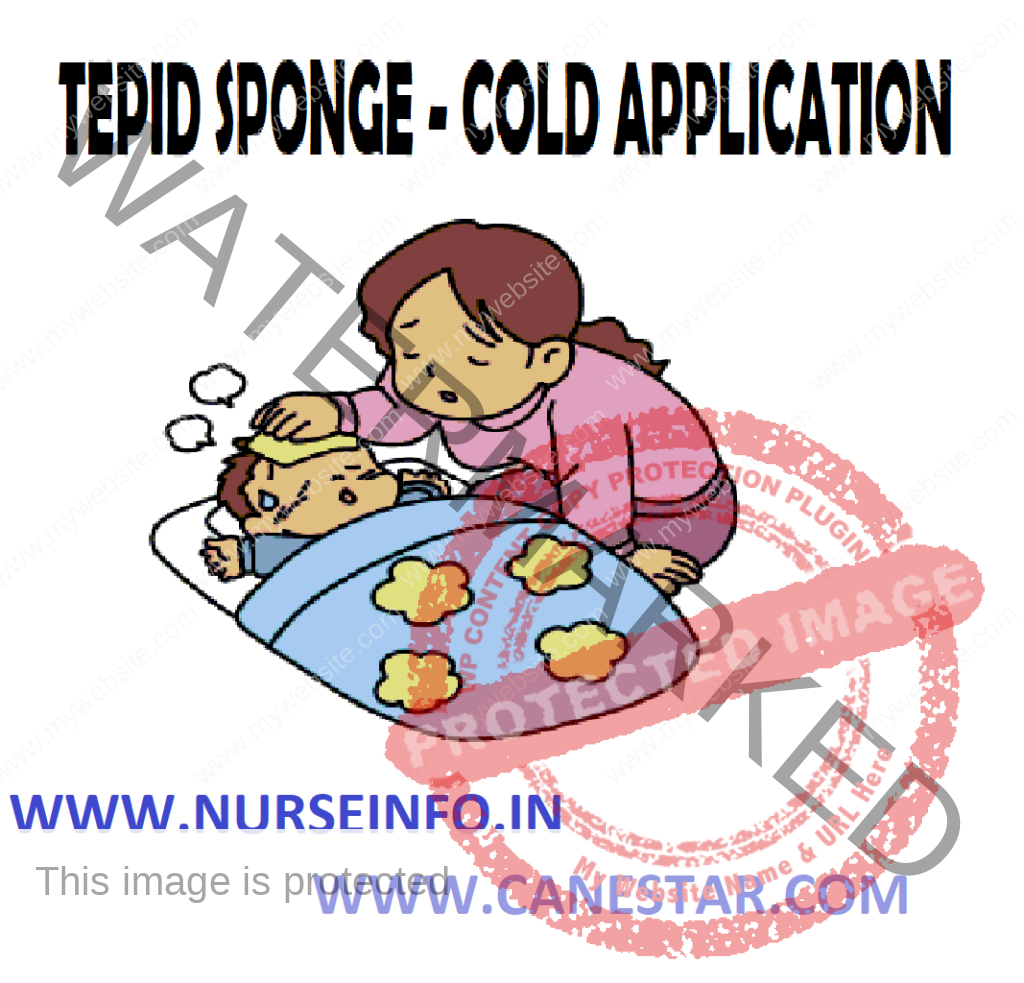TEPID SPONGE/COLD SPONGE (Cold Application) – Definition, Purpose, General Instructions, Preliminary Assessment Check, Effects, Physiologic Effects, Indications, Preparation of the Patient and Environment, Equipment, Procedure, After Care and Contraindications
Updated 2024
Tepid sponging or cold sponging is a general application of moist cold liquid to cool skin, by evaporation and by the absorption of body heat in the cold water.
Tepid sponge is a process of sponging with tepid water to reduce body temperature by evaporation. The temperature of water used for tepid sponge is 80-90 degree F.
COMMON NURSING ARTICLE AND PROCEDURE CLICK HERE
- Tepid Sponge:
- Tepid water is lukewarm, neither hot nor cold. It is often recommended for cleaning wounds or sensitive skin.
- It can be more comfortable for general cleaning tasks, as extreme temperatures can be harsh on the skin.
- Tepid water is suitable for washing the face or body, especially if you have sensitive skin.
- Cold Sponge:
- Cold water can be refreshing and invigorating, making it a good choice for hot weather or when you need a pick-me-up.
- It can help reduce inflammation and soothe sore muscles or joints.
- Cold water may be preferred for some beauty routines, as it can tighten pores and give a refreshing feeling to the skin.
PURPOSE
- Tepid sponge helps to reduce the temperature between 102 and 102.8 degree F.
- Cold sponge helps reduce the temperature of above 103 degree F.
- To stimulate circulation
- To decrease toxicity
- Nervousness and delirium
- To soothe the nerves and promote sleep
GENERAL INSTRUCTIONS
- Cold sponging is used to reduce temperature in a patient with hyperpyrexia
- Large areas of the body are sponged at one time, permitting the heat of the body to transfer to the cooler solution on the body surface.
- Often wet towels are applied to the neck, axillae, groin and ankles, where the blood circulation is close to the skin surface
- The vital signs are checked very frequently to detect the early signs of complications
- The physiological effect of the cold applications are vaso-constriction, decreased blood circulation, decreased capillary permeability, decreased metabolism, decreased blood viscosity, etc.
- The application moist cold is more effective than the application of dry cold as the moisture distributes the cold to large and deep area
- There must be a written order for tepid sponge or cold sponge
- Use long strokes for sponging and avoid circular movements or friction while sponging
- Keep the hot water bag ready at the foot end of the bed
PRELIMINARY ASSESSMENT
Check
- The doctors order for any specific instructions
- General condition and diagnosis
- Self-care ability of the patient
- Assess the duration of application
- For contraindication to cold application
- Articles available in the unit
PREPARATION OF THE PATIENT AND ENVIRONMENT
- Explain the sequence of the procedure
- Provide privacy
- Check the initial temperature and should be checked every 15 minutes intervals
- Position the patient comfortably in the bed
- Remove the patient gown and place with bath blanket
- Bring the patient to the edge of the bed
- Place the long Mackintosh and draw sheet under the patient
- Arrange the articles to the bedside
PROCEDURE
- Wash hands
- Mix the water with ice cubes
- Soak the wash cloths in the ice cold water for some time
- Place cold sponge cloths in each axial and groin
- Put the face towel under the head sponge the face and dry with face towel
- Sponge the neck, right arm from the shoulder to the finger tips for 3 minutes
- Change sponge cloth when it becomes warm
- Sponge the left arm, chest and abdomen for 3 minutes
- Change the water if it becomes dirty and check the temperature
- Cover the upper half, of the body and expose the lower half of the body
- Sponge the right and left lower limb for 3 minutes
- Then carefully turn the patient for his side and bring patient to edge of bed. Sponge the back with long strokes for 3 minutes
- Dry the part with bath towel and apply spirit on the back
- Check the temperature at 20 minutes interval and record it in the TPR chart
COMMON NURSING ARTICLE AND PROCEDURE CLICK HERE
EQUIPMENT
- A large basin of water (80-90 degree F) for tepid sponging
- Jug with cold water
- Basin with ice pieces
- Bath thermometer
- Mackintosh and draw sheet
- Sponge clothes – 6
- Bath towel – 1
- Face towel – 1
- Thermometer tray
- Ice cap with cover
- Spirit rub
- Bucket
AFTER CARE
- Remove the sponge clothes from the axilla and groin. Discard it in kidney tray
- Dry the body with bath towel
- Remove the Mackintosh and draw sheet
- Replace the gown and remove the bath blanket
- Observe for any symptoms of chill or any other abnormality
- If needed give him hot drinks
- Position the patient comfortably in the bed
- Replace the articles after cleaning
- Wash hands
- Record the procedure in the nurse’s record sheet and vital signs in TPR sheet

NURSING PROCEDURES LIST CLICK HERE
NURSING IMPORTANT QUESTIONS – CLICK HERE

